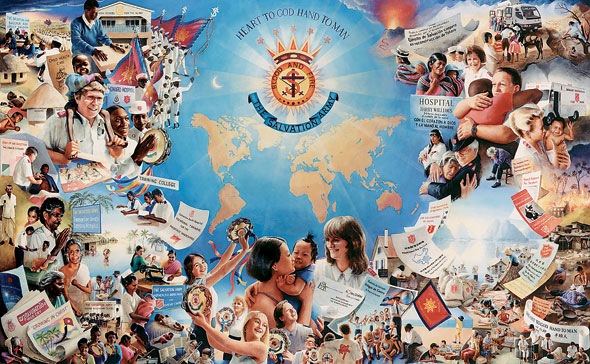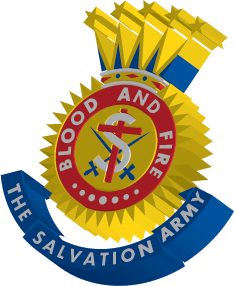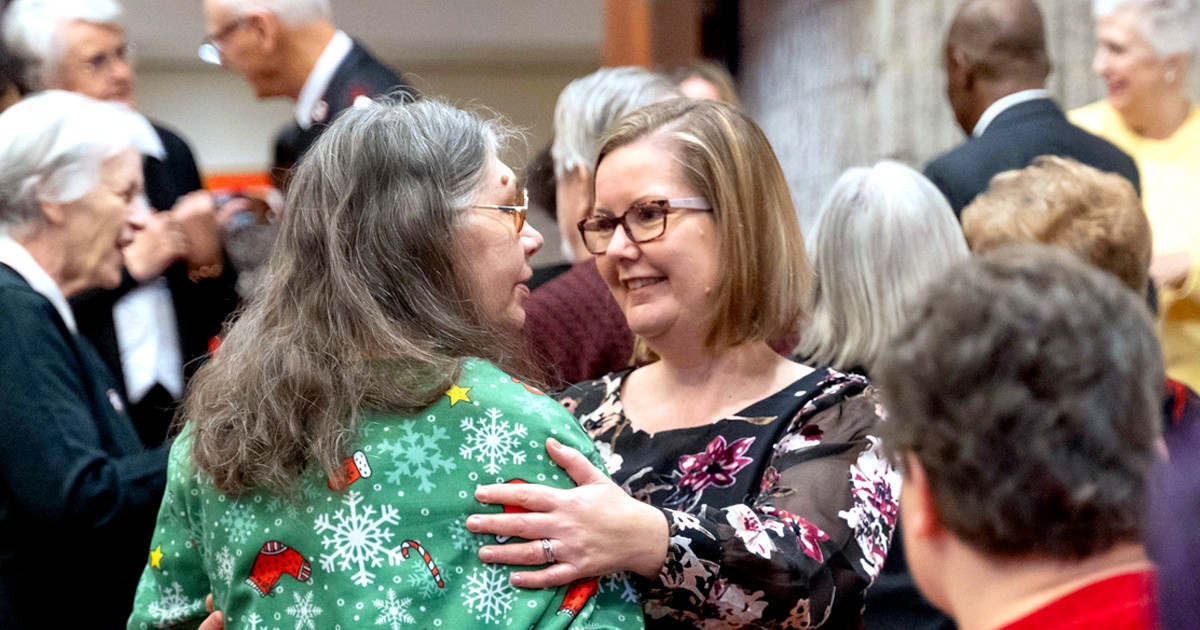 Two centuries ago, William Booth, a Methodist minister preaching in the east end of London, England, had a vision that would impact every corner of the globe. His small Christian Mission became The Salvation Army and expanded its influence internationally. First Wales and Scotland, then outside Great Britain to the United States, Australia, France and Canada. Within 18 years, William Booth had sent pioneers to countries such as India, Sri Lanka and South Africa. Today, The Salvation Army is serving in 117 countries.
Two centuries ago, William Booth, a Methodist minister preaching in the east end of London, England, had a vision that would impact every corner of the globe. His small Christian Mission became The Salvation Army and expanded its influence internationally. First Wales and Scotland, then outside Great Britain to the United States, Australia, France and Canada. Within 18 years, William Booth had sent pioneers to countries such as India, Sri Lanka and South Africa. Today, The Salvation Army is serving in 117 countries.
But what makes The Salvation Army unique? As one part of the universal Church of Jesus Christ, how are we distinct from other Christian traditions and denominations?
Doctrine of Salvation
Salvationists embrace the call to salvation by grace through faith in our Lord Jesus Christ. Salvation is so important to us that we have incorporated the word into our very name and the theme forms the fulcrum of our 11 doctrines. Every soldier (member) gives testimony to their personal salvation experience, and the entire thrust of the Movement exists to see people come to salvation.
Our Founder, William Booth, said it best: “We are a salvation people—this is our specialty—getting saved and keeping saved, and then getting somebody else saved, and then getting saved ourselves more and more … We believe the world needs it, and that this alone will set it right.”
We cherish the belief that “whosoever will may be saved.” This grand truth has been proven innumerable times as individuals forgotten by society in general, and overlooked by the Church in particular, have found and followed Christ through the Army.
Other symbolism further reinforces this motif: the cross is the centre of the Army crest; the mercy seat (altar) is the focal point of a Salvation Army hall; and the call to pray at that altar is the high point of our worship. Officers regularly “preach for a decision” and nothing will lift the morale of corps more than an individual getting saved.
The gospel section is the largest portion of The Song Book of The Salvation Army. At the heart of this section stands the Founder's song:
O boundless salvation! deep ocean of love,
O fullness of mercy, Christ brought from above,
The whole world redeeming, so rich and so free,
Now flowing for all men, come, roll over me! (SASB 298)
To this all Salvationists resound, “Amen!”
Militancy
Certainly the most distinguishing aspect of The Salvation Army within the Christian Church is our “quasi-military” organizational structure. The accompanying symbolism and imagery truly reflect that we are an army. Military motifs permeate our Movement with our uniforms, ranks, flags, crest and shield.
These symbols, however, are simply the form of the Army. If we do not view the rich biblical imagery regarding spiritual warfare as a reality to be engaged, we will miss the true militant spirit of The Salvation Army. From the Old Testament depictions of God's people capturing the land of Canaan from the evil grip of Baal to the New Testament image of Christians wearing the spiritual armour of God, there are numerous references to our spiritual lives as ones of raging conflict with the forces of evil. This is the driving force of Salvationism and revolutionizes the manner in which we perceive our spirituality and role in the Church.
In practical terms, this means The Salvation Army engages in service where spiritual warfare is toughest and where evil is most rampant. Whether it is the vice and squalor of an urban ghetto or the catastrophe of a natural disaster, the Army is mobilized as a Christian presence.
Salvationists are under no illusion regarding the enormity of the strife. From the moment individuals become soldiers and sign their Soldier's Covenants until the day they are promoted to Glory, there is righteous warfare to be waged.
Social Ministry
In the eyes of the public, it is the social ministry of The Salvation Army that is most readily recognized. This expression of our faith is all-encompassing, creative and professional.
At the heart of this compassionate ministry is the cherished belief that in reaching out to the hungry, thirsty, lonely, naked, sick and imprisoned, we are actually reaching out to Christ himself. Salvationists see Jesus in the homeless shelter, in the alcoholic rehabilitation centre and in our community and family services.
This diversity is an expression of the holistic gospel in which The Salvation Army so passionately believes. The spiritual and social aspects of the Christian gospel combine to form an integrated ministry. We believe that it is artificial and unscriptural to separate the two.
General Frederick Coutts articulated this holistic concept of social work and evangelical work: “It is not that these are two distinct entities which could operate one without the other. They are but two activities of the one and the same salvation which is concerned with the total redemption of man. Both rely upon the same grace. Both are inspired with the same motive. Both have the same end in mind. And as the gospel has joined them together we do not propose to put them asunder.”
 World Mission
World Mission
Another distinctive feature is our sense of global mission. While many churches have a missionary society, and some denominations are specifically committed to missions, The Salvation Army uniquely fuses local culture with world mission. Every member automatically becomes part of an international Movement. The Salvation Army is active in 117 countries, proclaiming the gospel in more than 175 languages.
A key principle to our unity through diversity is the active encouragement for each ethnic group to express Salvationism through worship and service that is culturally natural to them. It is a thrilling sight at an international congress to witness the multicultural dimension of The Salvation Army. At such a gathering one sees a true representation of the Kingdom of Heaven.
Worship
The Salvation Army does many things in the name of Christ throughout the week, but the call to worship is the high point. The weekly gathering of Salvationist congregations in worship provides the spiritual energy and focus for every other expression of the gospel.
Scripture paints a picture of worship that includes both private introspection and exuberant community celebration. The pageantry of flags and the fanfare of brass join with spontaneous acts of hand-clapping and the tambourine in joyful expressions of worship. On other occasions quiet prayer and reflective meditation are more appropriate.
The Salvation Army combines rich ceremony with down-to-earth practicality. The enrolment of soldiers or the commissioning of officers are dignified liturgical acts. The same participants, however, are equally ready to lead devotions around a summer campfire or pray with a seeker at an open-air meeting.
The focal point of the Salvation Army corps is the altar. The mercy seat is a physical location where people can meet with God to receive the graces of salvation and sanctification.
Salvationists covet regular worship as vital to personal Christian growth. From this “heart to God” comes the motivation to stretch out a “hand to man.”
Doctrine of Holiness
The Salvation Army is a vital expression of the holiness movement that originates from the theology of John Wesley. Scriptural holiness is such a distinguishing feature of our Movement that our 10th doctrine is the only one phrased entirely in the words of Scripture. The holiness section of our songbook is recognized as a definitive collection of such hymns. The central worship event of the local corps is known as the holiness meeting.
Holy living is revolutionary indeed. It transforms the world as we know it
The Salvation Army's teaching on holiness is breathtaking in its scope and adds dynamism to the spiritual life of the believer. It is captured in our motto as “Blood and Fire!” Blood for salvation available through atoning the death of Christ; fire for the energizing contagion of the Holy Spirit!
It is important to note that the grace of sanctification continues the grace of salvation. Salvation emphasizes forgiveness for sins; sanctification emphasizes empowerment for spiritual growth. The first grace entails the past, the second accentuates the future. A stirring Salvation Army distinction is the conviction that this grace is for all believers.
Entire sanctification can be misunderstood as sinless perfection or freedom from temptation and trials. This is unfortunate, as it can lead to religious neurosis. The emphasis is more on perfect love in which the Holy Spirit dwells in his fullness. It is the work of God and impossible to attain by human effort. It is a necessary work and not considered optional.
Sanctifying grace is received in the same manner as saving grace. We recognize the need for God to work again in our lives and realize that the Holy Spirit is available to us. We confess sin and by faith commit ourselves fully to accept God's grace.
The beautiful thing is that holy living need not be caricatured, but is to be expressed through our unique personality. The whole person will be changed, but we will remain! This remarkable distinctive teaches that purity of heart and life can be fully experienced on earth. We are to be “blameless unto the coming of our Lord Jesus Christ.” Perfect love is for the here and now, not at some point later in Heaven!
Holy living is revolutionary indeed. It transforms the world as we know it. The prayer of young William Booth, “God shall have all there is of me,” demonstrates the power of God's holiness. From such consecration The Salvation Army was born.
Position on the Sacraments
The Salvation Army does not formally observe the sacraments as part of its faith and practice. This truly is a theological distinctive. Our perspective is rich in history and content, and provides an opportunity for Salvationists to engage in dialogue with both Christians and non-believers.
The issue is complex and has been questioned within and outside The Salvation Army. The task is to continue exploring the richness of the subject and use the ensuing exchange of ideas as the basis for deeper faith in Christ.
The scriptural basis for our position is rooted in the conviction that Jesus Christ came to offer humankind new life in him alone. There is strong evidence in Scripture that Jesus opposed religious ceremony as an end in itself. It is considered a misinterpretation to believe that he would institute additional religious ritual.
With regard to tradition, the Army views itself as providing a distinctive witness to the universal Church concerning the non-observance of sacraments. Salvationists stand as a reminder to the Church that grace is mediated from Christ, not Christ and prescribed ceremony.
Church history has demonstrated that ritual can become an end in itself, devoid of spiritual meaning. Fixed ceremony has resulted in painful division and early Salvationists saw this issue as a hindrance to the greater mission of evangelism.
Salvationists respect fellow believers for whom the sacraments are a means of grace. We recognize that we are very much in the minority. We believe, however, that our position enriches rather than diminishes the universality of the Christian message.
Women in Ministry
While many denominations grapple today with the role of women in ministry, the Army has commissioned and ordained women since its inception. We have been a pioneer in this regard. The role of women in the growth and development of The Salvation Army is inestimable.
Women in leadership is crucial to holistic ministry. Women can reach out to mothers, battered wives and prostitutes in ways impossible for a man.
Today, the role of Salvation Army women in ministry is still under vigorous revaluation and scrutiny. It would seem the potential for even more influence and responsibility is a pressing reality. This climate affords women of The Salvation Army the responsibility to forge and implement their own vision of ministry. It also challenges Salvationist men to actively encourage such a development.
Conclusion
These themes, often featured in our literature and expounded from our pulpits, are essential to the mission of our Movement. As a whole they articulate the heart of Salvation Army faith and practice. They are our humble, yet precious, contribution to the Church.
Lt-Colonel Richard Munn is the Principal of the International College for Officers and Centre for Spiritual Life Development.
Top photo: Entitled With Heart to God and Hand to Man, artist Rosa Branson's painting depicts the international work of The Salvation Army.









Leave a Comment